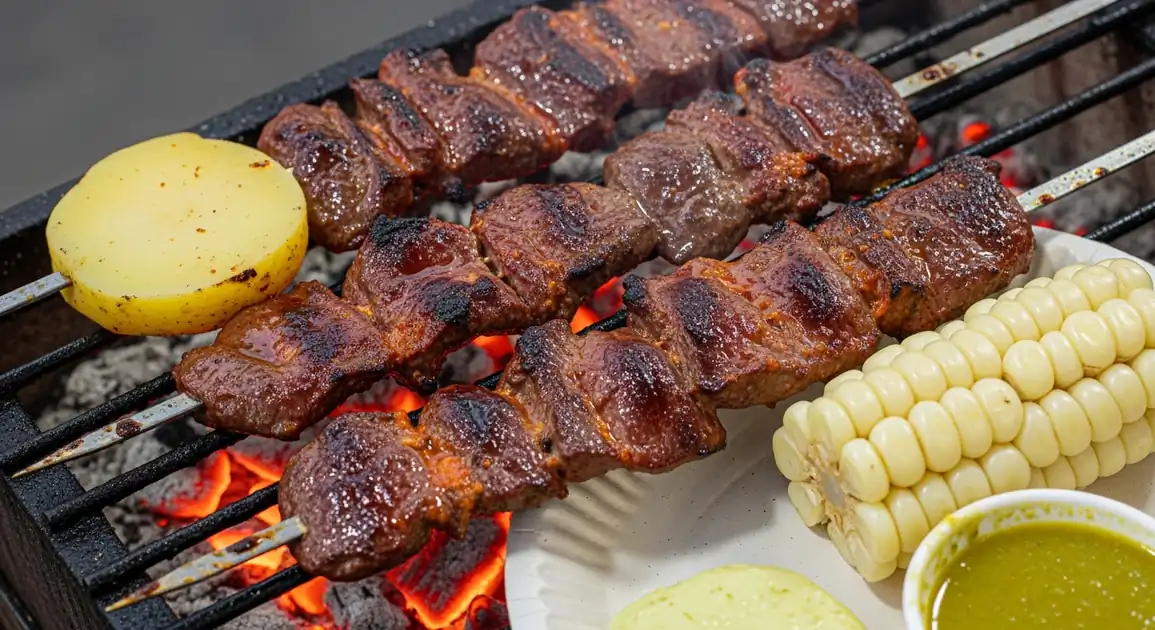Anticuchos (Grilled Beef Heart Skewers)
Anticuchos

Description
Anticuchos are a national dish of Peru, found throughout the country but particularly iconic as street food in Lima. From bustling city streets to local festivals and specialized restaurants ('anticucherías'), they are a beloved part of Peruvian gastronomy, especially enjoyed in the evenings.
Dietary Information
Serving information
Serving style
Typically served as 2-3 skewers on a plate, accompanied by a boiled potato slice, boiled choclo (corn), and a side of ají amarillo or rocoto chili sauce for dipping. Eaten hot.
Quick facts
Primarily evening and late night (approx. 6 PM - 1 AM or later).
Safety Tips
What to Look For
-
Cooked fresh to order over hot coals
Ensures the meat is cooked thoroughly at high temperature, killing potential pathogens and providing the best flavor/texture.
-
Meat cooked through (no raw spots)
Beef heart must be fully cooked. Check visually for any remaining pinkness before consuming.
-
Clean grill and utensils
The grill surface, tongs used for turning meat, and any cutting boards should appear clean to prevent cross-contamination.
-
Fresh appearance of meat and sides
Skewered meat should look well-marinated and reasonably fresh. Potatoes and corn should not look old or dried out.
-
Busy vendor with good reputation
High turnover suggests fresher ingredients and adherence to quality standards appreciated by locals.
What to avoid
-
Pre-cooked anticuchos sitting off the heat
Avoid skewers that have been cooked earlier and are just being kept warm or reheated inadequately.
-
Visibly raw or undercooked meat
Undercooked organ meat carries significant health risks. Do not eat if you see pink/raw areas.
-
Dirty grill or preparation area
Greasy buildup, old food debris, or general lack of cleanliness increases contamination risk.
-
Meat or sides look dried out, discolored, or smell off
Indicates poor quality ingredients or improper storage.
Price information
Price range
Budget tips
- Street vendors offer the most affordable prices, typically 8-15 PEN for a serving (2-3 skewers with sides).
- Dedicated 'anticucherías' might charge slightly more (15-25 PEN) but often offer a wider menu and seating.
- Prices at upscale restaurants will be significantly higher.
Value indicators
- Generous portion size (number of meat chunks per skewer).
- Served piping hot off the grill.
- Fresh potato and choclo accompaniments.
- Flavorful, well-balanced marinade.
Where to Find This Dish
Street Corners (Nationwide)
Iconic setup with portable charcoal grills found on many busy street corners, especially in Lima.
Various cities and towns
Evening, Late Night
Local Markets ('Mercados')
Some markets have food sections where anticucho vendors operate, particularly in the evenings.
Markets in Lima, Arequipa, Cusco
Evening
Festivals and Fairs
A staple food offering at most public celebrations and festivals across Peru.
Various event locations
Event hours (often evening)
Vendor Tips
- Follow the aroma of grilling meat and ají panca – it's distinctive!
- Observe how the vendor cooks – consistent turning and basting usually yields better results.
- Don't be afraid to ask for less spicy sauce ('sin picante' or 'un poquito de ají nomás').
How to Order
Regional Variations
-
Anticuchos de Corazón
(Anticuchos de Corazón)
The classic and most traditional version made with beef heart.
-
Anticuchos de Pollo
(Anticuchos de Pollo)
A common alternative using chicken breast or thigh pieces, marinated similarly.
-
Anticuchos de Res
(Anticuchos de Res)
Made with regular beef cuts (like sirloin), less common and usually more expensive than beef heart.
-
Fish/Seafood Anticuchos
(Anticuchos de Pescado/Mariscos)
Found occasionally, especially in coastal areas, using firm fish or seafood marinated and grilled.
-
Varying Spiciness
(Nivel de Picante)
The heat level can vary based on the amount of ají panca in the marinade and the type/amount of ají sauce served alongside.
Cultural context
History
The origins of anticuchos trace back to pre-Columbian times in the Andes, where llama meat may have been prepared similarly. The modern version, using beef heart and vinegar marinade, solidified during the Spanish colonial period, heavily influenced by enslaved Africans who were often given offal cuts. They adapted their techniques and spices, transforming beef heart into this flavorful and enduring street food staple, now enjoyed by all social classes.
Local significance
A beloved national dish with deep historical roots, representing resourcefulness and the fusion of indigenous, Spanish, and African influences. A staple of Peruvian street food culture.
Eating customs
- Typically eaten standing up or at basic seating near the vendor's stall.
- Dipping the meat and potato into the ají sauce is essential.